Student Satisfaction Report: University of Greenwich, Vietnam Campus
VerifiedAdded on 2021/04/05
|30
|9399
|71
Report
AI Summary
This report, submitted by Tran Khanh Linh, assesses student satisfaction with the educational services at the University of Greenwich, Vietnam campus. The study investigates factors influencing student satisfaction, including teaching methodologies, facilities, and overall student experiences. It reviews relevant literature on satisfaction, teaching methods, and facilities. The methodology involves a 24-question survey distributed to current students, and the report presents descriptive statistics, including tables, figures, and diagrams, alongside inferential statistical analyses like one-sample, independent samples, and paired samples tests. The findings explore various aspects of the learning environment, such as teaching knowledge, course materials, lecturer attitudes, classroom facilities, equipment, internet connectivity, and extracurricular activities. The report concludes with recommendations to improve the educational service and enhance student satisfaction at the University of Greenwich.
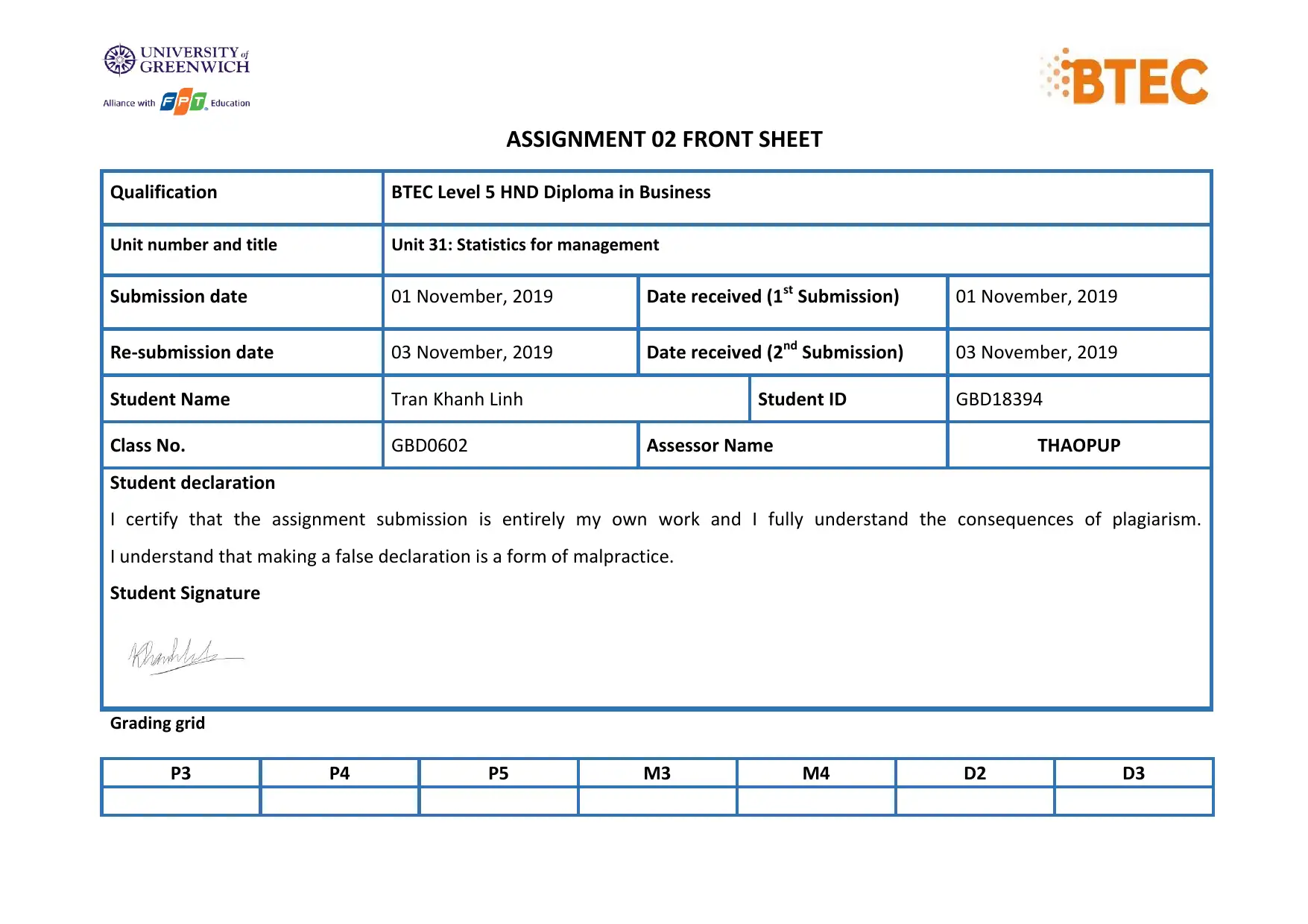
ASSIGNMENT 02 FRONT SHEET
Qualification BTEC Level 5 HND Diploma in Business
Unit number and title Unit 31: Statistics for management
Submission date 01 November, 2019 Date received (1st Submission) 01 November, 2019
Re-submission date 03 November, 2019 Date received (2nd Submission) 03 November, 2019
Student Name Tran Khanh Linh Student ID GBD18394
Class No. GBD0602 Assessor Name THAOPUP
Student declaration
I certify that the assignment submission is entirely my own work and I fully understand the consequences of plagiarism.
I understand that making a false declaration is a form of malpractice.
Student Signature
Grading grid
P3 P4 P5 M3 M4 D2 D3
Qualification BTEC Level 5 HND Diploma in Business
Unit number and title Unit 31: Statistics for management
Submission date 01 November, 2019 Date received (1st Submission) 01 November, 2019
Re-submission date 03 November, 2019 Date received (2nd Submission) 03 November, 2019
Student Name Tran Khanh Linh Student ID GBD18394
Class No. GBD0602 Assessor Name THAOPUP
Student declaration
I certify that the assignment submission is entirely my own work and I fully understand the consequences of plagiarism.
I understand that making a false declaration is a form of malpractice.
Student Signature
Grading grid
P3 P4 P5 M3 M4 D2 D3
Paraphrase This Document
Need a fresh take? Get an instant paraphrase of this document with our AI Paraphraser
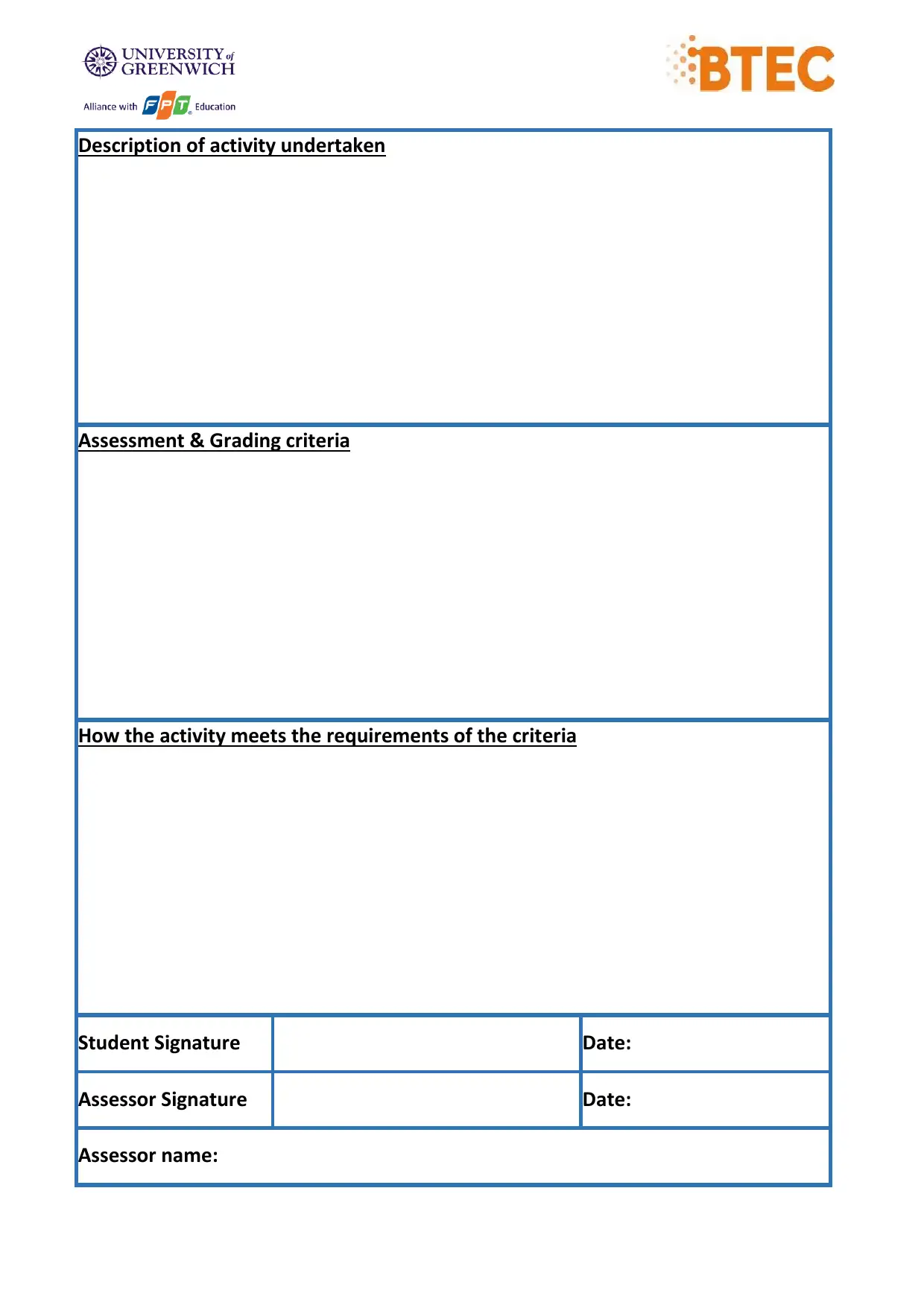
Description of activity undertaken
Assessment & Grading criteria
How the activity meets the requirements of the criteria
Student Signature Date:
Assessor Signature Date:
Assessor name:
Assessment & Grading criteria
How the activity meets the requirements of the criteria
Student Signature Date:
Assessor Signature Date:
Assessor name:
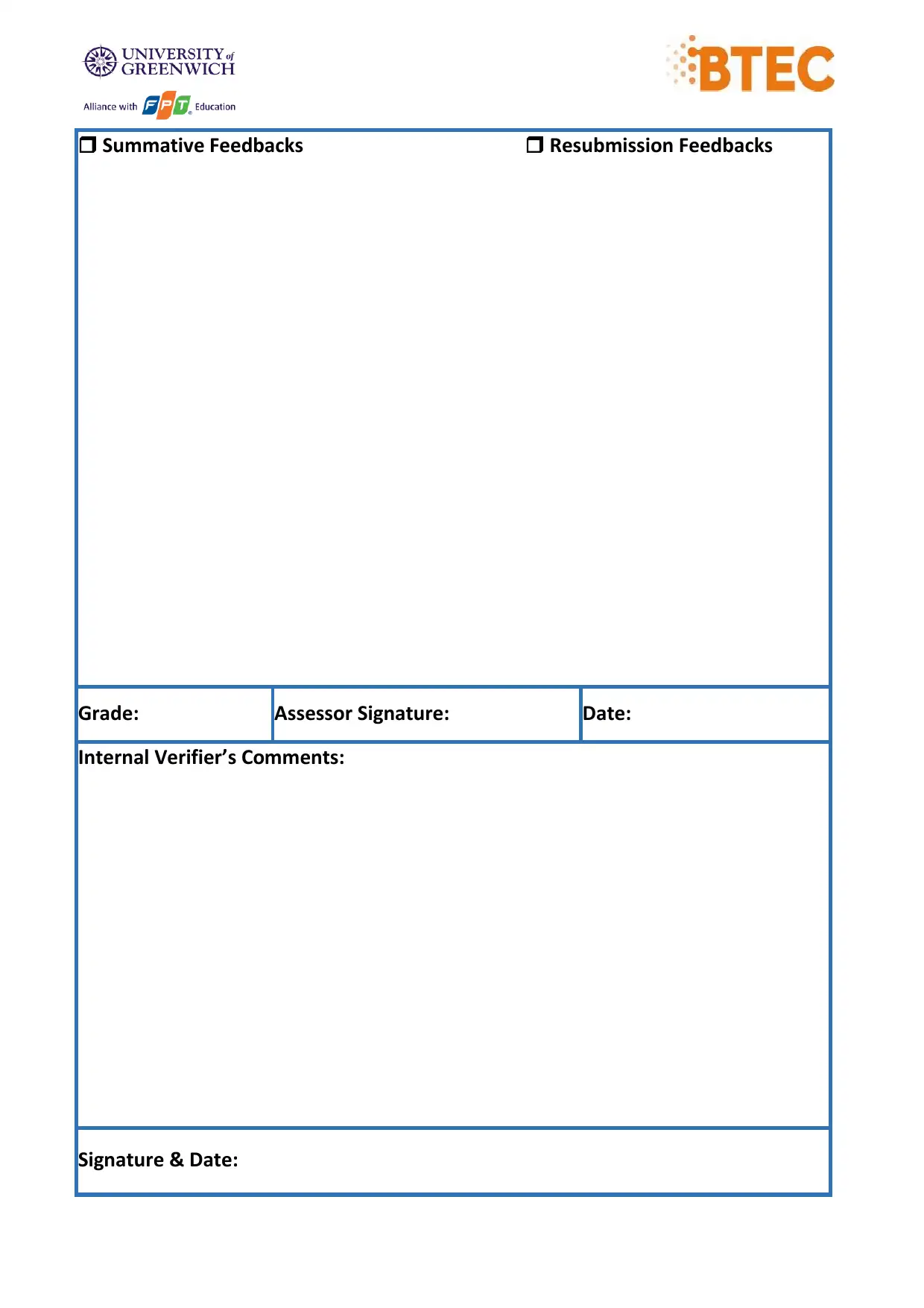
Summative Feedbacks Resubmission Feedbacks
Grade: Assessor Signature: Date:
Internal Verifier’s Comments:
Signature & Date:
Grade: Assessor Signature: Date:
Internal Verifier’s Comments:
Signature & Date:
⊘ This is a preview!⊘
Do you want full access?
Subscribe today to unlock all pages.

Trusted by 1+ million students worldwide
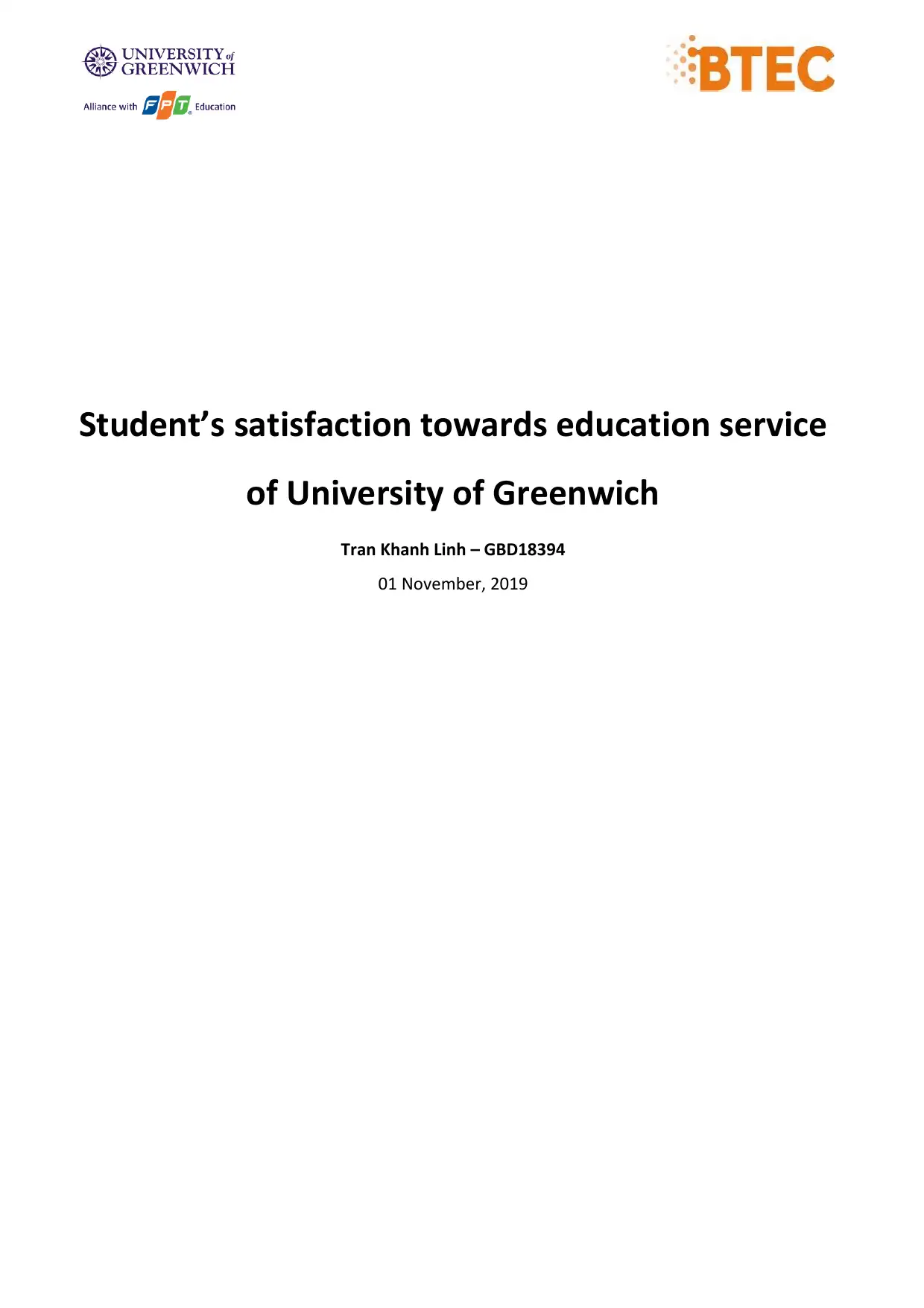
Student’s satisfaction towards education service
of University of Greenwich
Tran Khanh Linh – GBD18394
01 November, 2019
of University of Greenwich
Tran Khanh Linh – GBD18394
01 November, 2019
Paraphrase This Document
Need a fresh take? Get an instant paraphrase of this document with our AI Paraphraser
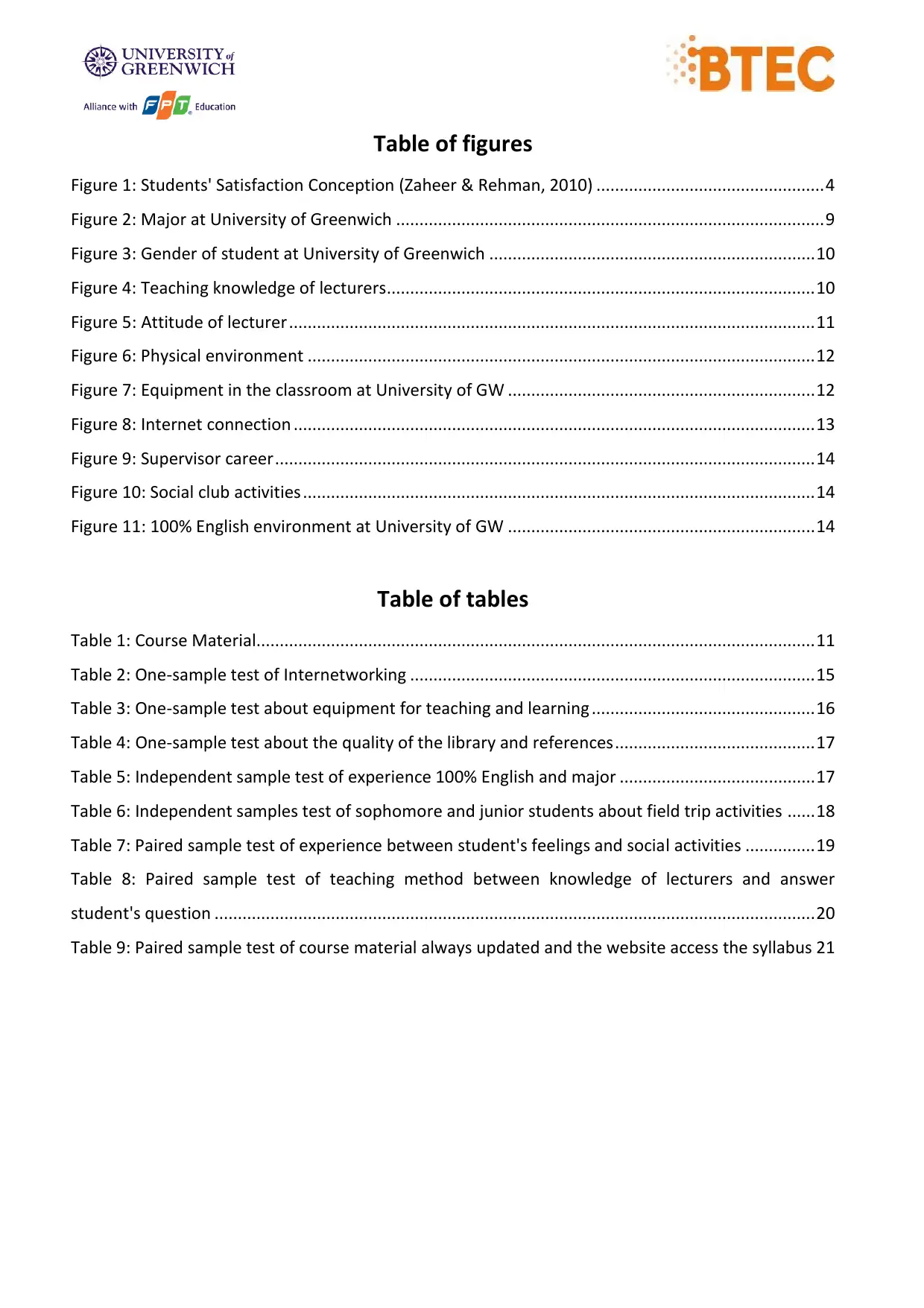
Table of figures
Figure 1: Students' Satisfaction Conception (Zaheer & Rehman, 2010) ................................................. 4
Figure 2: Major at University of Greenwich ............................................................................................ 9
Figure 3: Gender of student at University of Greenwich ...................................................................... 10
Figure 4: Teaching knowledge of lecturers............................................................................................ 10
Figure 5: Attitude of lecturer ................................................................................................................. 11
Figure 6: Physical environment ............................................................................................................. 12
Figure 7: Equipment in the classroom at University of GW .................................................................. 12
Figure 8: Internet connection ................................................................................................................ 13
Figure 9: Supervisor career .................................................................................................................... 14
Figure 10: Social club activities .............................................................................................................. 14
Figure 11: 100% English environment at University of GW .................................................................. 14
Table of tables
Table 1: Course Material........................................................................................................................ 11
Table 2: One-sample test of Internetworking ....................................................................................... 15
Table 3: One-sample test about equipment for teaching and learning ................................................ 16
Table 4: One-sample test about the quality of the library and references ........................................... 17
Table 5: Independent sample test of experience 100% English and major .......................................... 17
Table 6: Independent samples test of sophomore and junior students about field trip activities ...... 18
Table 7: Paired sample test of experience between student's feelings and social activities ............... 19
Table 8: Paired sample test of teaching method between knowledge of lecturers and answer
student's question ................................................................................................................................. 20
Table 9: Paired sample test of course material always updated and the website access the syllabus 21
Figure 1: Students' Satisfaction Conception (Zaheer & Rehman, 2010) ................................................. 4
Figure 2: Major at University of Greenwich ............................................................................................ 9
Figure 3: Gender of student at University of Greenwich ...................................................................... 10
Figure 4: Teaching knowledge of lecturers............................................................................................ 10
Figure 5: Attitude of lecturer ................................................................................................................. 11
Figure 6: Physical environment ............................................................................................................. 12
Figure 7: Equipment in the classroom at University of GW .................................................................. 12
Figure 8: Internet connection ................................................................................................................ 13
Figure 9: Supervisor career .................................................................................................................... 14
Figure 10: Social club activities .............................................................................................................. 14
Figure 11: 100% English environment at University of GW .................................................................. 14
Table of tables
Table 1: Course Material........................................................................................................................ 11
Table 2: One-sample test of Internetworking ....................................................................................... 15
Table 3: One-sample test about equipment for teaching and learning ................................................ 16
Table 4: One-sample test about the quality of the library and references ........................................... 17
Table 5: Independent sample test of experience 100% English and major .......................................... 17
Table 6: Independent samples test of sophomore and junior students about field trip activities ...... 18
Table 7: Paired sample test of experience between student's feelings and social activities ............... 19
Table 8: Paired sample test of teaching method between knowledge of lecturers and answer
student's question ................................................................................................................................. 20
Table 9: Paired sample test of course material always updated and the website access the syllabus 21
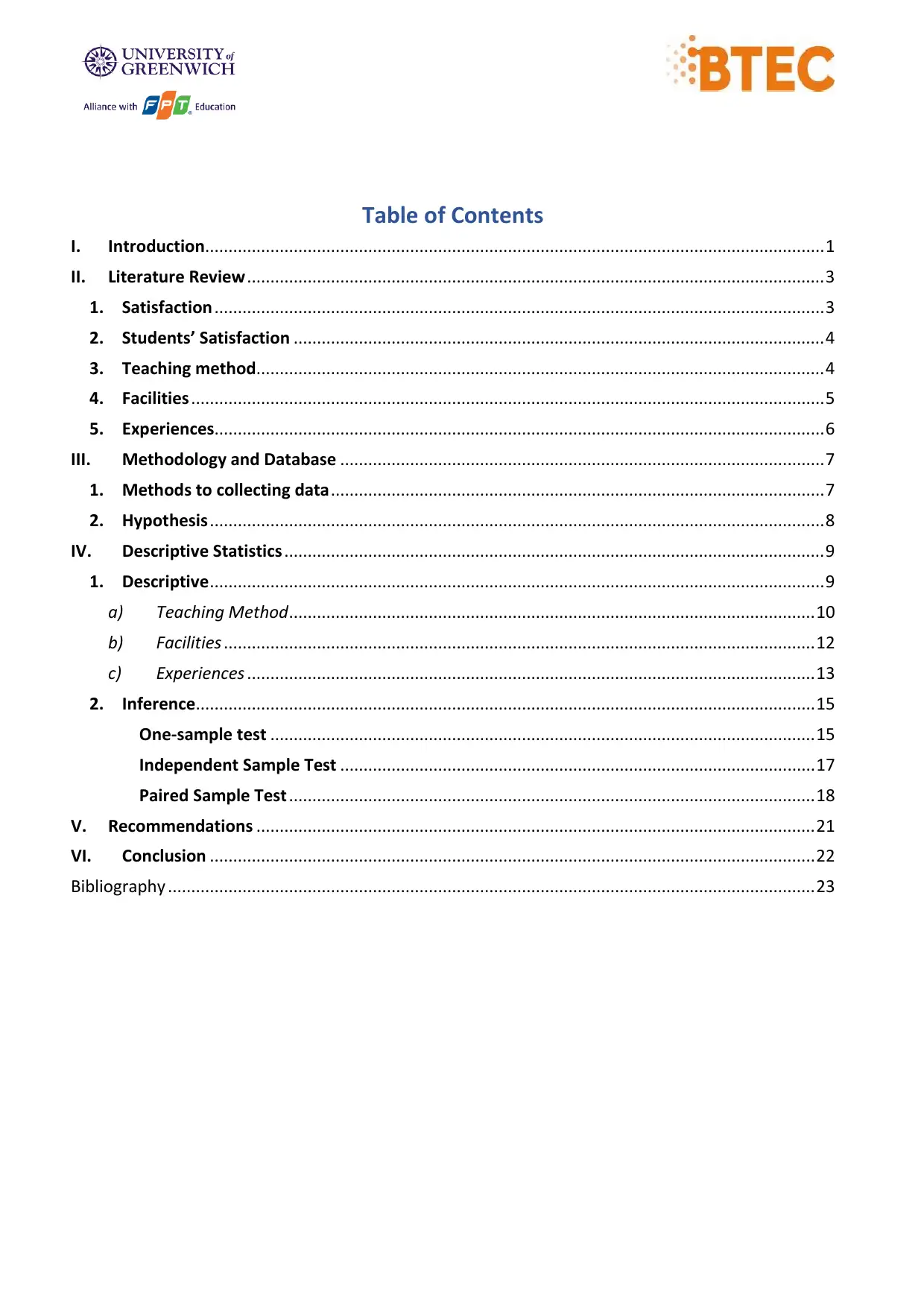
Table of Contents
I. Introduction..................................................................................................................................... 1
II. Literature Review ............................................................................................................................ 3
1. Satisfaction ................................................................................................................................... 3
2. Students’ Satisfaction .................................................................................................................. 4
3. Teaching method.......................................................................................................................... 4
4. Facilities ........................................................................................................................................ 5
5. Experiences................................................................................................................................... 6
III. Methodology and Database ........................................................................................................ 7
1. Methods to collecting data .......................................................................................................... 7
2. Hypothesis .................................................................................................................................... 8
IV. Descriptive Statistics .................................................................................................................... 9
1. Descriptive .................................................................................................................................... 9
a) Teaching Method................................................................................................................. 10
b) Facilities ............................................................................................................................... 12
c) Experiences .......................................................................................................................... 13
2. Inference..................................................................................................................................... 15
One-sample test ..................................................................................................................... 15
Independent Sample Test ...................................................................................................... 17
Paired Sample Test ................................................................................................................. 18
V. Recommendations ........................................................................................................................ 21
VI. Conclusion .................................................................................................................................. 22
Bibliography ........................................................................................................................................... 23
I. Introduction..................................................................................................................................... 1
II. Literature Review ............................................................................................................................ 3
1. Satisfaction ................................................................................................................................... 3
2. Students’ Satisfaction .................................................................................................................. 4
3. Teaching method.......................................................................................................................... 4
4. Facilities ........................................................................................................................................ 5
5. Experiences................................................................................................................................... 6
III. Methodology and Database ........................................................................................................ 7
1. Methods to collecting data .......................................................................................................... 7
2. Hypothesis .................................................................................................................................... 8
IV. Descriptive Statistics .................................................................................................................... 9
1. Descriptive .................................................................................................................................... 9
a) Teaching Method................................................................................................................. 10
b) Facilities ............................................................................................................................... 12
c) Experiences .......................................................................................................................... 13
2. Inference..................................................................................................................................... 15
One-sample test ..................................................................................................................... 15
Independent Sample Test ...................................................................................................... 17
Paired Sample Test ................................................................................................................. 18
V. Recommendations ........................................................................................................................ 21
VI. Conclusion .................................................................................................................................. 22
Bibliography ........................................................................................................................................... 23
⊘ This is a preview!⊘
Do you want full access?
Subscribe today to unlock all pages.

Trusted by 1+ million students worldwide
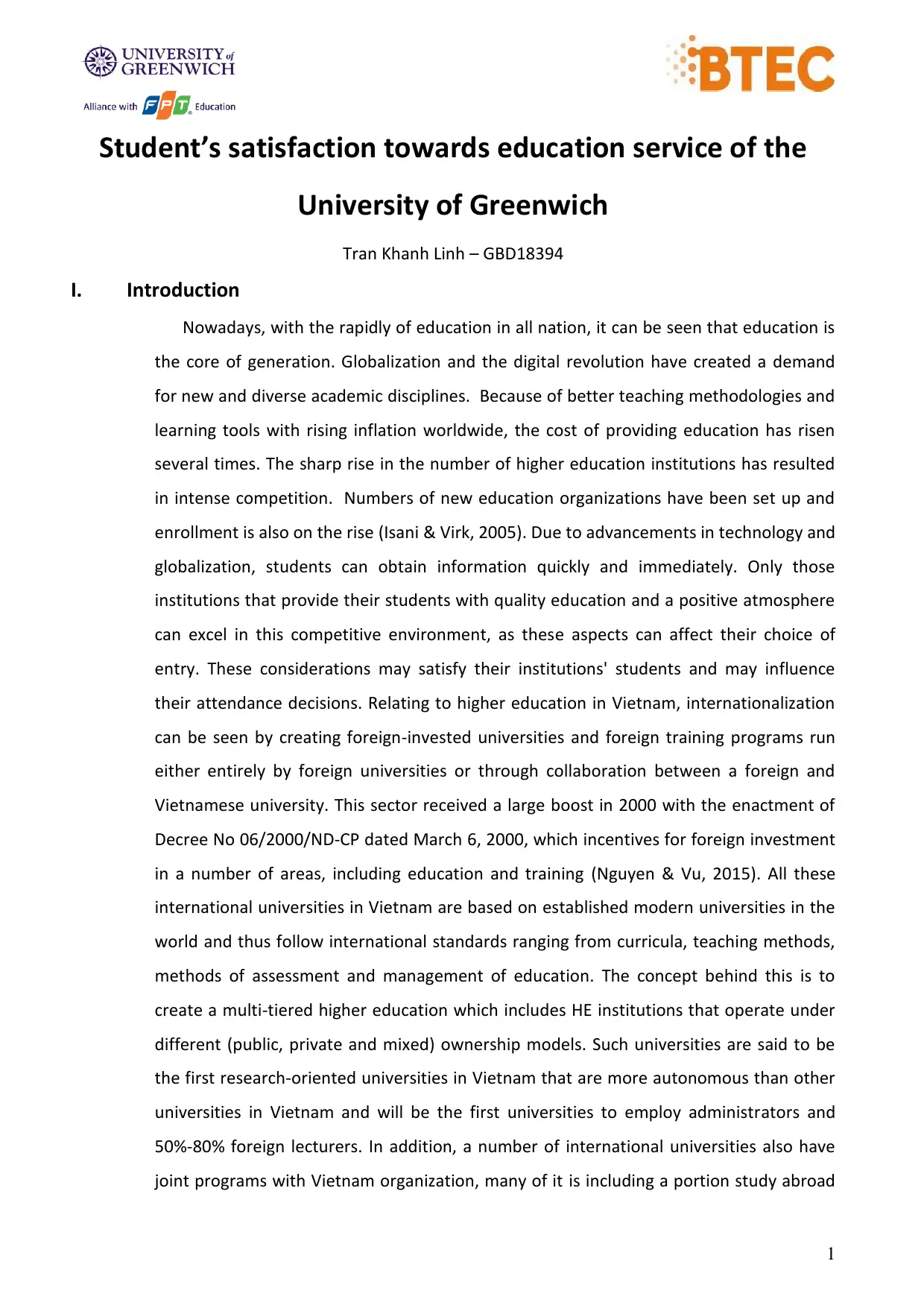
1
Student’s satisfaction towards education service of the
University of Greenwich
Tran Khanh Linh – GBD18394
I. Introduction
Nowadays, with the rapidly of education in all nation, it can be seen that education is
the core of generation. Globalization and the digital revolution have created a demand
for new and diverse academic disciplines. Because of better teaching methodologies and
learning tools with rising inflation worldwide, the cost of providing education has risen
several times. The sharp rise in the number of higher education institutions has resulted
in intense competition. Numbers of new education organizations have been set up and
enrollment is also on the rise (Isani & Virk, 2005). Due to advancements in technology and
globalization, students can obtain information quickly and immediately. Only those
institutions that provide their students with quality education and a positive atmosphere
can excel in this competitive environment, as these aspects can affect their choice of
entry. These considerations may satisfy their institutions' students and may influence
their attendance decisions. Relating to higher education in Vietnam, internationalization
can be seen by creating foreign-invested universities and foreign training programs run
either entirely by foreign universities or through collaboration between a foreign and
Vietnamese university. This sector received a large boost in 2000 with the enactment of
Decree No 06/2000/ND-CP dated March 6, 2000, which incentives for foreign investment
in a number of areas, including education and training (Nguyen & Vu, 2015). All these
international universities in Vietnam are based on established modern universities in the
world and thus follow international standards ranging from curricula, teaching methods,
methods of assessment and management of education. The concept behind this is to
create a multi-tiered higher education which includes HE institutions that operate under
different (public, private and mixed) ownership models. Such universities are said to be
the first research-oriented universities in Vietnam that are more autonomous than other
universities in Vietnam and will be the first universities to employ administrators and
50%-80% foreign lecturers. In addition, a number of international universities also have
joint programs with Vietnam organization, many of it is including a portion study abroad
Student’s satisfaction towards education service of the
University of Greenwich
Tran Khanh Linh – GBD18394
I. Introduction
Nowadays, with the rapidly of education in all nation, it can be seen that education is
the core of generation. Globalization and the digital revolution have created a demand
for new and diverse academic disciplines. Because of better teaching methodologies and
learning tools with rising inflation worldwide, the cost of providing education has risen
several times. The sharp rise in the number of higher education institutions has resulted
in intense competition. Numbers of new education organizations have been set up and
enrollment is also on the rise (Isani & Virk, 2005). Due to advancements in technology and
globalization, students can obtain information quickly and immediately. Only those
institutions that provide their students with quality education and a positive atmosphere
can excel in this competitive environment, as these aspects can affect their choice of
entry. These considerations may satisfy their institutions' students and may influence
their attendance decisions. Relating to higher education in Vietnam, internationalization
can be seen by creating foreign-invested universities and foreign training programs run
either entirely by foreign universities or through collaboration between a foreign and
Vietnamese university. This sector received a large boost in 2000 with the enactment of
Decree No 06/2000/ND-CP dated March 6, 2000, which incentives for foreign investment
in a number of areas, including education and training (Nguyen & Vu, 2015). All these
international universities in Vietnam are based on established modern universities in the
world and thus follow international standards ranging from curricula, teaching methods,
methods of assessment and management of education. The concept behind this is to
create a multi-tiered higher education which includes HE institutions that operate under
different (public, private and mixed) ownership models. Such universities are said to be
the first research-oriented universities in Vietnam that are more autonomous than other
universities in Vietnam and will be the first universities to employ administrators and
50%-80% foreign lecturers. In addition, a number of international universities also have
joint programs with Vietnam organization, many of it is including a portion study abroad
Paraphrase This Document
Need a fresh take? Get an instant paraphrase of this document with our AI Paraphraser
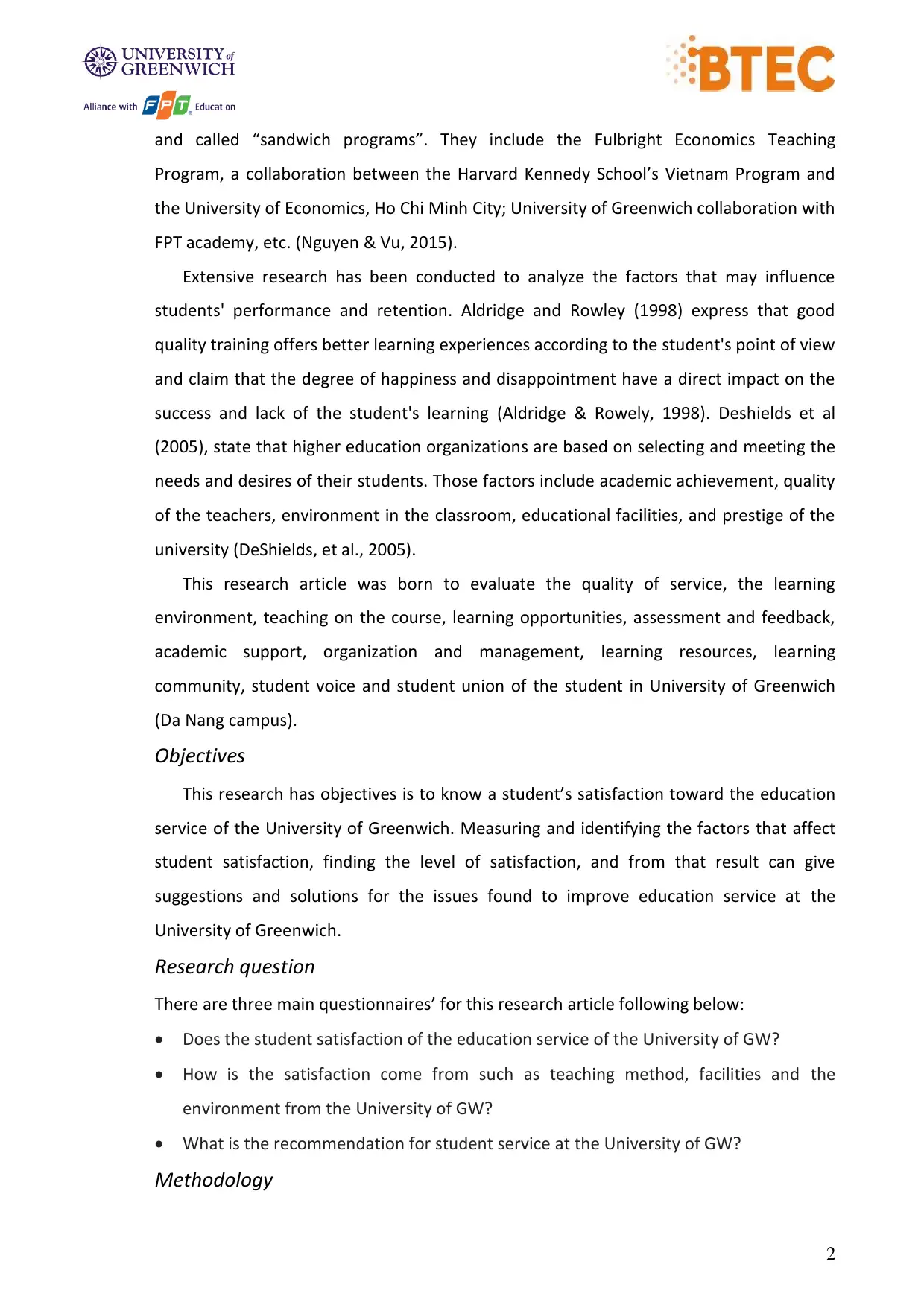
2
and called “sandwich programs”. They include the Fulbright Economics Teaching
Program, a collaboration between the Harvard Kennedy School’s Vietnam Program and
the University of Economics, Ho Chi Minh City; University of Greenwich collaboration with
FPT academy, etc. (Nguyen & Vu, 2015).
Extensive research has been conducted to analyze the factors that may influence
students' performance and retention. Aldridge and Rowley (1998) express that good
quality training offers better learning experiences according to the student's point of view
and claim that the degree of happiness and disappointment have a direct impact on the
success and lack of the student's learning (Aldridge & Rowely, 1998). Deshields et al
(2005), state that higher education organizations are based on selecting and meeting the
needs and desires of their students. Those factors include academic achievement, quality
of the teachers, environment in the classroom, educational facilities, and prestige of the
university (DeShields, et al., 2005).
This research article was born to evaluate the quality of service, the learning
environment, teaching on the course, learning opportunities, assessment and feedback,
academic support, organization and management, learning resources, learning
community, student voice and student union of the student in University of Greenwich
(Da Nang campus).
Objectives
This research has objectives is to know a student’s satisfaction toward the education
service of the University of Greenwich. Measuring and identifying the factors that affect
student satisfaction, finding the level of satisfaction, and from that result can give
suggestions and solutions for the issues found to improve education service at the
University of Greenwich.
Research question
There are three main questionnaires’ for this research article following below:
Does the student satisfaction of the education service of the University of GW?
How is the satisfaction come from such as teaching method, facilities and the
environment from the University of GW?
What is the recommendation for student service at the University of GW?
Methodology
and called “sandwich programs”. They include the Fulbright Economics Teaching
Program, a collaboration between the Harvard Kennedy School’s Vietnam Program and
the University of Economics, Ho Chi Minh City; University of Greenwich collaboration with
FPT academy, etc. (Nguyen & Vu, 2015).
Extensive research has been conducted to analyze the factors that may influence
students' performance and retention. Aldridge and Rowley (1998) express that good
quality training offers better learning experiences according to the student's point of view
and claim that the degree of happiness and disappointment have a direct impact on the
success and lack of the student's learning (Aldridge & Rowely, 1998). Deshields et al
(2005), state that higher education organizations are based on selecting and meeting the
needs and desires of their students. Those factors include academic achievement, quality
of the teachers, environment in the classroom, educational facilities, and prestige of the
university (DeShields, et al., 2005).
This research article was born to evaluate the quality of service, the learning
environment, teaching on the course, learning opportunities, assessment and feedback,
academic support, organization and management, learning resources, learning
community, student voice and student union of the student in University of Greenwich
(Da Nang campus).
Objectives
This research has objectives is to know a student’s satisfaction toward the education
service of the University of Greenwich. Measuring and identifying the factors that affect
student satisfaction, finding the level of satisfaction, and from that result can give
suggestions and solutions for the issues found to improve education service at the
University of Greenwich.
Research question
There are three main questionnaires’ for this research article following below:
Does the student satisfaction of the education service of the University of GW?
How is the satisfaction come from such as teaching method, facilities and the
environment from the University of GW?
What is the recommendation for student service at the University of GW?
Methodology
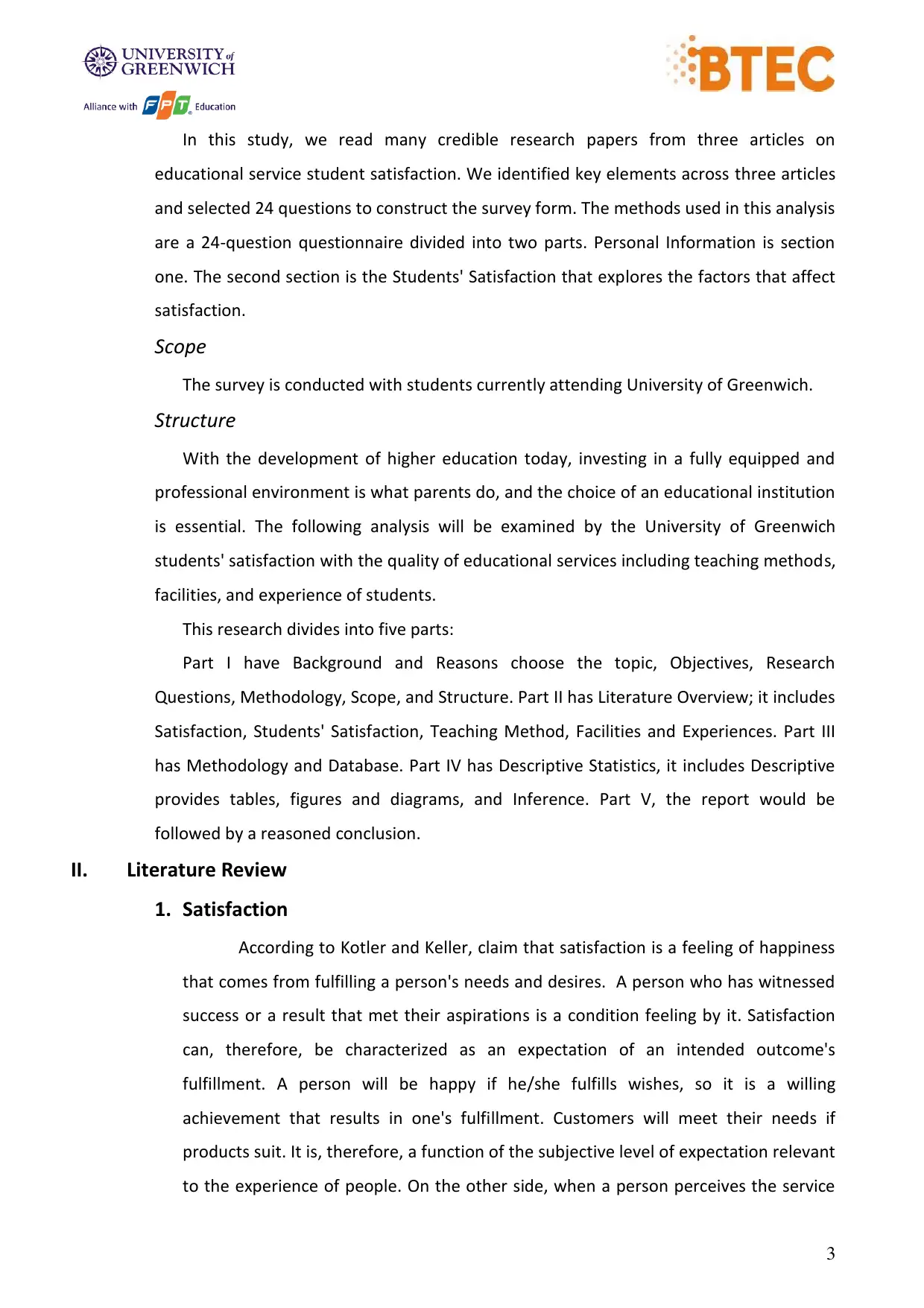
3
In this study, we read many credible research papers from three articles on
educational service student satisfaction. We identified key elements across three articles
and selected 24 questions to construct the survey form. The methods used in this analysis
are a 24-question questionnaire divided into two parts. Personal Information is section
one. The second section is the Students' Satisfaction that explores the factors that affect
satisfaction.
Scope
The survey is conducted with students currently attending University of Greenwich.
Structure
With the development of higher education today, investing in a fully equipped and
professional environment is what parents do, and the choice of an educational institution
is essential. The following analysis will be examined by the University of Greenwich
students' satisfaction with the quality of educational services including teaching methods,
facilities, and experience of students.
This research divides into five parts:
Part I have Background and Reasons choose the topic, Objectives, Research
Questions, Methodology, Scope, and Structure. Part II has Literature Overview; it includes
Satisfaction, Students' Satisfaction, Teaching Method, Facilities and Experiences. Part III
has Methodology and Database. Part IV has Descriptive Statistics, it includes Descriptive
provides tables, figures and diagrams, and Inference. Part V, the report would be
followed by a reasoned conclusion.
II. Literature Review
1. Satisfaction
According to Kotler and Keller, claim that satisfaction is a feeling of happiness
that comes from fulfilling a person's needs and desires. A person who has witnessed
success or a result that met their aspirations is a condition feeling by it. Satisfaction
can, therefore, be characterized as an expectation of an intended outcome's
fulfillment. A person will be happy if he/she fulfills wishes, so it is a willing
achievement that results in one's fulfillment. Customers will meet their needs if
products suit. It is, therefore, a function of the subjective level of expectation relevant
to the experience of people. On the other side, when a person perceives the service
In this study, we read many credible research papers from three articles on
educational service student satisfaction. We identified key elements across three articles
and selected 24 questions to construct the survey form. The methods used in this analysis
are a 24-question questionnaire divided into two parts. Personal Information is section
one. The second section is the Students' Satisfaction that explores the factors that affect
satisfaction.
Scope
The survey is conducted with students currently attending University of Greenwich.
Structure
With the development of higher education today, investing in a fully equipped and
professional environment is what parents do, and the choice of an educational institution
is essential. The following analysis will be examined by the University of Greenwich
students' satisfaction with the quality of educational services including teaching methods,
facilities, and experience of students.
This research divides into five parts:
Part I have Background and Reasons choose the topic, Objectives, Research
Questions, Methodology, Scope, and Structure. Part II has Literature Overview; it includes
Satisfaction, Students' Satisfaction, Teaching Method, Facilities and Experiences. Part III
has Methodology and Database. Part IV has Descriptive Statistics, it includes Descriptive
provides tables, figures and diagrams, and Inference. Part V, the report would be
followed by a reasoned conclusion.
II. Literature Review
1. Satisfaction
According to Kotler and Keller, claim that satisfaction is a feeling of happiness
that comes from fulfilling a person's needs and desires. A person who has witnessed
success or a result that met their aspirations is a condition feeling by it. Satisfaction
can, therefore, be characterized as an expectation of an intended outcome's
fulfillment. A person will be happy if he/she fulfills wishes, so it is a willing
achievement that results in one's fulfillment. Customers will meet their needs if
products suit. It is, therefore, a function of the subjective level of expectation relevant
to the experience of people. On the other side, when a person perceives the service
⊘ This is a preview!⊘
Do you want full access?
Subscribe today to unlock all pages.

Trusted by 1+ million students worldwide
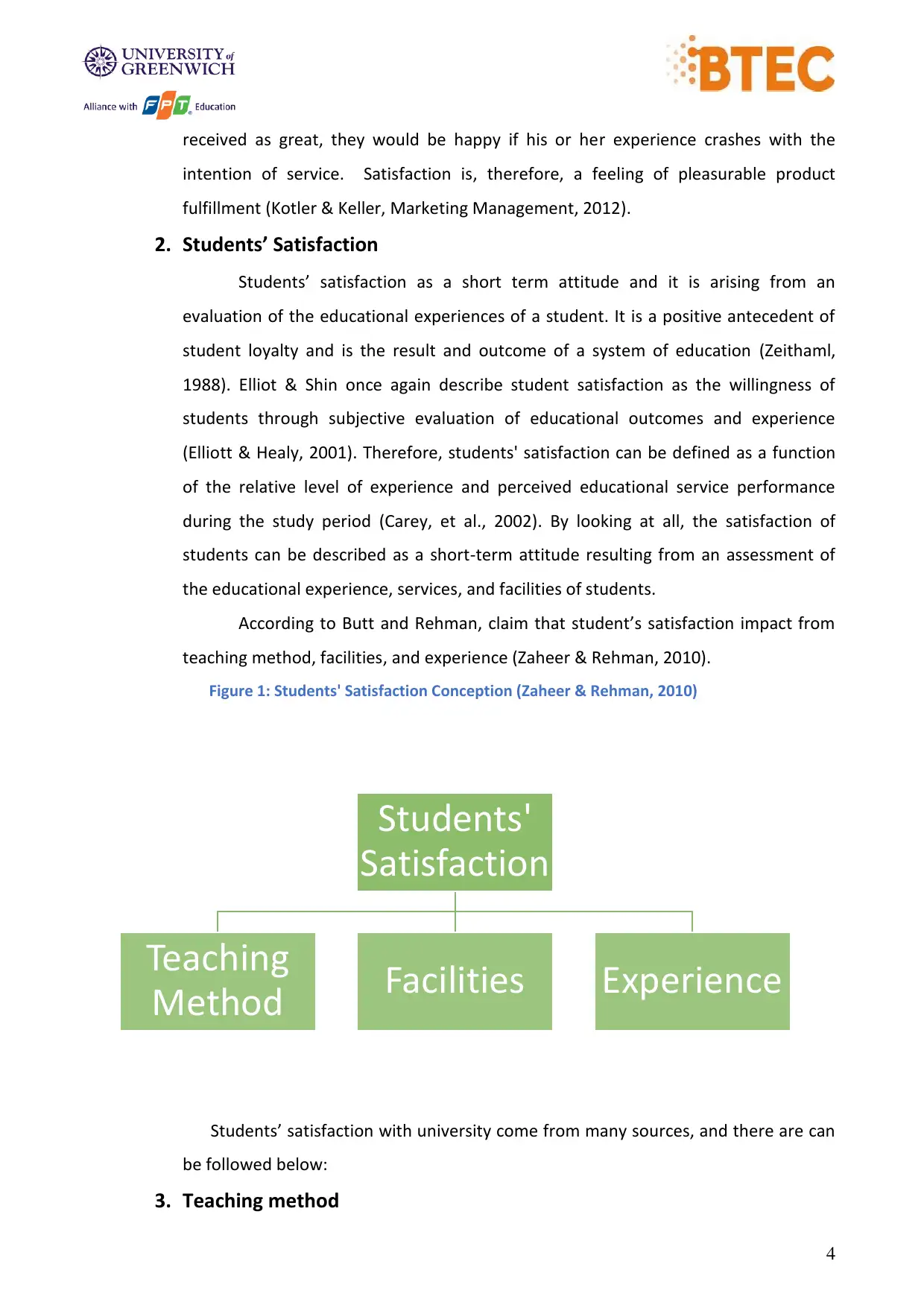
4
received as great, they would be happy if his or her experience crashes with the
intention of service. Satisfaction is, therefore, a feeling of pleasurable product
fulfillment (Kotler & Keller, Marketing Management, 2012).
2. Students’ Satisfaction
Students’ satisfaction as a short term attitude and it is arising from an
evaluation of the educational experiences of a student. It is a positive antecedent of
student loyalty and is the result and outcome of a system of education (Zeithaml,
1988). Elliot & Shin once again describe student satisfaction as the willingness of
students through subjective evaluation of educational outcomes and experience
(Elliott & Healy, 2001). Therefore, students' satisfaction can be defined as a function
of the relative level of experience and perceived educational service performance
during the study period (Carey, et al., 2002). By looking at all, the satisfaction of
students can be described as a short-term attitude resulting from an assessment of
the educational experience, services, and facilities of students.
According to Butt and Rehman, claim that student’s satisfaction impact from
teaching method, facilities, and experience (Zaheer & Rehman, 2010).
Figure 1: Students' Satisfaction Conception (Zaheer & Rehman, 2010)
Students’ satisfaction with university come from many sources, and there are can
be followed below:
3. Teaching method
Students'
Satisfaction
Teaching
Method Facilities Experience
received as great, they would be happy if his or her experience crashes with the
intention of service. Satisfaction is, therefore, a feeling of pleasurable product
fulfillment (Kotler & Keller, Marketing Management, 2012).
2. Students’ Satisfaction
Students’ satisfaction as a short term attitude and it is arising from an
evaluation of the educational experiences of a student. It is a positive antecedent of
student loyalty and is the result and outcome of a system of education (Zeithaml,
1988). Elliot & Shin once again describe student satisfaction as the willingness of
students through subjective evaluation of educational outcomes and experience
(Elliott & Healy, 2001). Therefore, students' satisfaction can be defined as a function
of the relative level of experience and perceived educational service performance
during the study period (Carey, et al., 2002). By looking at all, the satisfaction of
students can be described as a short-term attitude resulting from an assessment of
the educational experience, services, and facilities of students.
According to Butt and Rehman, claim that student’s satisfaction impact from
teaching method, facilities, and experience (Zaheer & Rehman, 2010).
Figure 1: Students' Satisfaction Conception (Zaheer & Rehman, 2010)
Students’ satisfaction with university come from many sources, and there are can
be followed below:
3. Teaching method
Students'
Satisfaction
Teaching
Method Facilities Experience
Paraphrase This Document
Need a fresh take? Get an instant paraphrase of this document with our AI Paraphraser
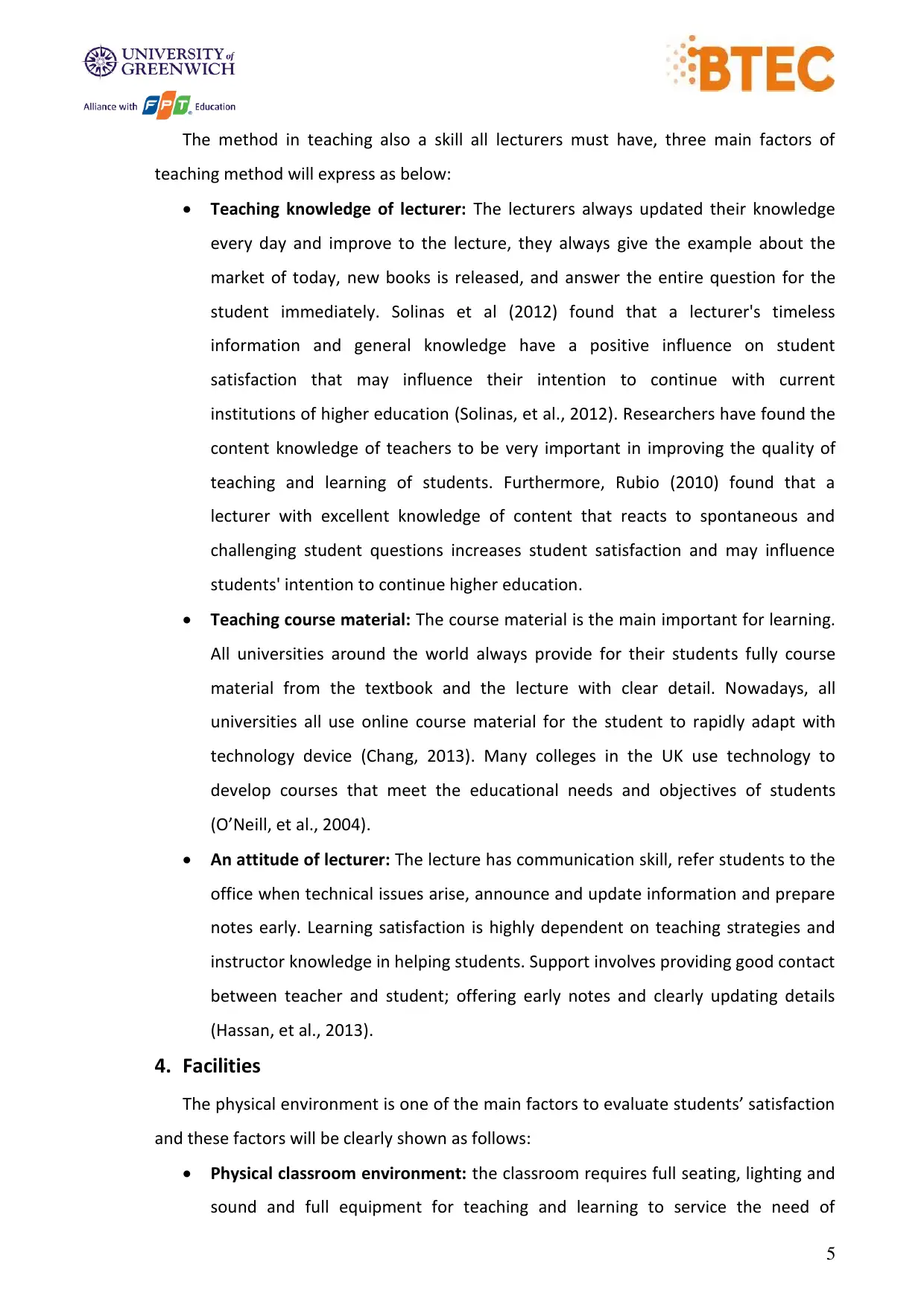
5
The method in teaching also a skill all lecturers must have, three main factors of
teaching method will express as below:
Teaching knowledge of lecturer: The lecturers always updated their knowledge
every day and improve to the lecture, they always give the example about the
market of today, new books is released, and answer the entire question for the
student immediately. Solinas et al (2012) found that a lecturer's timeless
information and general knowledge have a positive influence on student
satisfaction that may influence their intention to continue with current
institutions of higher education (Solinas, et al., 2012). Researchers have found the
content knowledge of teachers to be very important in improving the quality of
teaching and learning of students. Furthermore, Rubio (2010) found that a
lecturer with excellent knowledge of content that reacts to spontaneous and
challenging student questions increases student satisfaction and may influence
students' intention to continue higher education.
Teaching course material: The course material is the main important for learning.
All universities around the world always provide for their students fully course
material from the textbook and the lecture with clear detail. Nowadays, all
universities all use online course material for the student to rapidly adapt with
technology device (Chang, 2013). Many colleges in the UK use technology to
develop courses that meet the educational needs and objectives of students
(O’Neill, et al., 2004).
An attitude of lecturer: The lecture has communication skill, refer students to the
office when technical issues arise, announce and update information and prepare
notes early. Learning satisfaction is highly dependent on teaching strategies and
instructor knowledge in helping students. Support involves providing good contact
between teacher and student; offering early notes and clearly updating details
(Hassan, et al., 2013).
4. Facilities
The physical environment is one of the main factors to evaluate students’ satisfaction
and these factors will be clearly shown as follows:
Physical classroom environment: the classroom requires full seating, lighting and
sound and full equipment for teaching and learning to service the need of
The method in teaching also a skill all lecturers must have, three main factors of
teaching method will express as below:
Teaching knowledge of lecturer: The lecturers always updated their knowledge
every day and improve to the lecture, they always give the example about the
market of today, new books is released, and answer the entire question for the
student immediately. Solinas et al (2012) found that a lecturer's timeless
information and general knowledge have a positive influence on student
satisfaction that may influence their intention to continue with current
institutions of higher education (Solinas, et al., 2012). Researchers have found the
content knowledge of teachers to be very important in improving the quality of
teaching and learning of students. Furthermore, Rubio (2010) found that a
lecturer with excellent knowledge of content that reacts to spontaneous and
challenging student questions increases student satisfaction and may influence
students' intention to continue higher education.
Teaching course material: The course material is the main important for learning.
All universities around the world always provide for their students fully course
material from the textbook and the lecture with clear detail. Nowadays, all
universities all use online course material for the student to rapidly adapt with
technology device (Chang, 2013). Many colleges in the UK use technology to
develop courses that meet the educational needs and objectives of students
(O’Neill, et al., 2004).
An attitude of lecturer: The lecture has communication skill, refer students to the
office when technical issues arise, announce and update information and prepare
notes early. Learning satisfaction is highly dependent on teaching strategies and
instructor knowledge in helping students. Support involves providing good contact
between teacher and student; offering early notes and clearly updating details
(Hassan, et al., 2013).
4. Facilities
The physical environment is one of the main factors to evaluate students’ satisfaction
and these factors will be clearly shown as follows:
Physical classroom environment: the classroom requires full seating, lighting and
sound and full equipment for teaching and learning to service the need of
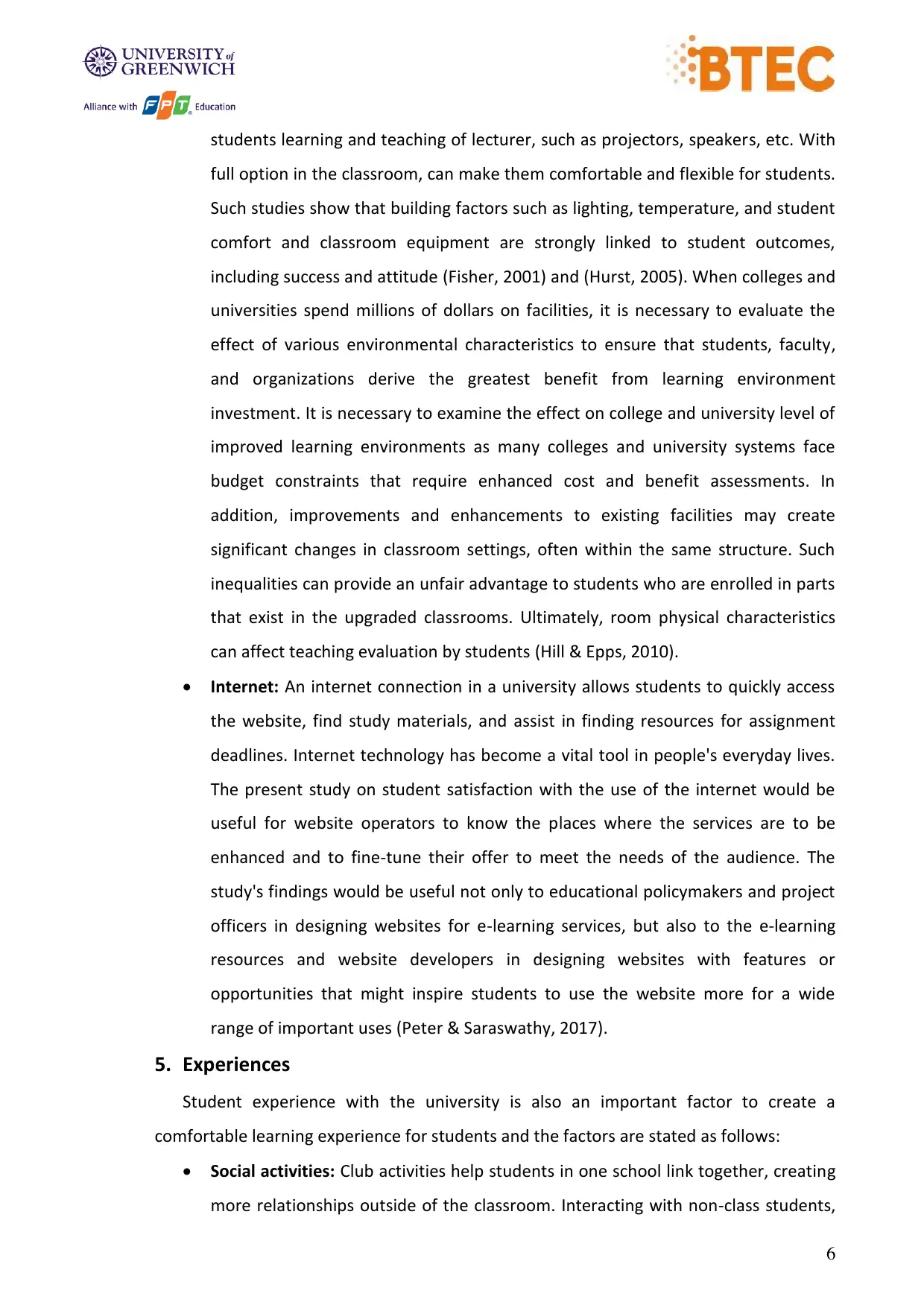
6
students learning and teaching of lecturer, such as projectors, speakers, etc. With
full option in the classroom, can make them comfortable and flexible for students.
Such studies show that building factors such as lighting, temperature, and student
comfort and classroom equipment are strongly linked to student outcomes,
including success and attitude (Fisher, 2001) and (Hurst, 2005). When colleges and
universities spend millions of dollars on facilities, it is necessary to evaluate the
effect of various environmental characteristics to ensure that students, faculty,
and organizations derive the greatest benefit from learning environment
investment. It is necessary to examine the effect on college and university level of
improved learning environments as many colleges and university systems face
budget constraints that require enhanced cost and benefit assessments. In
addition, improvements and enhancements to existing facilities may create
significant changes in classroom settings, often within the same structure. Such
inequalities can provide an unfair advantage to students who are enrolled in parts
that exist in the upgraded classrooms. Ultimately, room physical characteristics
can affect teaching evaluation by students (Hill & Epps, 2010).
Internet: An internet connection in a university allows students to quickly access
the website, find study materials, and assist in finding resources for assignment
deadlines. Internet technology has become a vital tool in people's everyday lives.
The present study on student satisfaction with the use of the internet would be
useful for website operators to know the places where the services are to be
enhanced and to fine-tune their offer to meet the needs of the audience. The
study's findings would be useful not only to educational policymakers and project
officers in designing websites for e-learning services, but also to the e-learning
resources and website developers in designing websites with features or
opportunities that might inspire students to use the website more for a wide
range of important uses (Peter & Saraswathy, 2017).
5. Experiences
Student experience with the university is also an important factor to create a
comfortable learning experience for students and the factors are stated as follows:
Social activities: Club activities help students in one school link together, creating
more relationships outside of the classroom. Interacting with non-class students,
students learning and teaching of lecturer, such as projectors, speakers, etc. With
full option in the classroom, can make them comfortable and flexible for students.
Such studies show that building factors such as lighting, temperature, and student
comfort and classroom equipment are strongly linked to student outcomes,
including success and attitude (Fisher, 2001) and (Hurst, 2005). When colleges and
universities spend millions of dollars on facilities, it is necessary to evaluate the
effect of various environmental characteristics to ensure that students, faculty,
and organizations derive the greatest benefit from learning environment
investment. It is necessary to examine the effect on college and university level of
improved learning environments as many colleges and university systems face
budget constraints that require enhanced cost and benefit assessments. In
addition, improvements and enhancements to existing facilities may create
significant changes in classroom settings, often within the same structure. Such
inequalities can provide an unfair advantage to students who are enrolled in parts
that exist in the upgraded classrooms. Ultimately, room physical characteristics
can affect teaching evaluation by students (Hill & Epps, 2010).
Internet: An internet connection in a university allows students to quickly access
the website, find study materials, and assist in finding resources for assignment
deadlines. Internet technology has become a vital tool in people's everyday lives.
The present study on student satisfaction with the use of the internet would be
useful for website operators to know the places where the services are to be
enhanced and to fine-tune their offer to meet the needs of the audience. The
study's findings would be useful not only to educational policymakers and project
officers in designing websites for e-learning services, but also to the e-learning
resources and website developers in designing websites with features or
opportunities that might inspire students to use the website more for a wide
range of important uses (Peter & Saraswathy, 2017).
5. Experiences
Student experience with the university is also an important factor to create a
comfortable learning experience for students and the factors are stated as follows:
Social activities: Club activities help students in one school link together, creating
more relationships outside of the classroom. Interacting with non-class students,
⊘ This is a preview!⊘
Do you want full access?
Subscribe today to unlock all pages.

Trusted by 1+ million students worldwide
1 out of 30
Related Documents
Your All-in-One AI-Powered Toolkit for Academic Success.
+13062052269
info@desklib.com
Available 24*7 on WhatsApp / Email
![[object Object]](/_next/static/media/star-bottom.7253800d.svg)
Unlock your academic potential
Copyright © 2020–2025 A2Z Services. All Rights Reserved. Developed and managed by ZUCOL.





